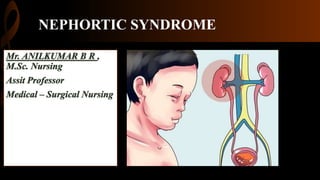
Nephortic syndrome
- 2. OVERVEIW •Nephrotic syndrome may be caused by primary (idiopathic) renal disease or by a variety of secondary causes. Patients present with marked edema, proteinuria, hypoalbuminemia, and often hyperlipidemia.
- 3. NEPHORTIC SYNDROME • Nephrotic syndrome is a primary glomerular disease characterized by the following: Marked increase in protein in the urine (proteinuria) Decrease in albumin in the blood (hypoalbuminemia) Edema (The swelling (edema), can be most noticeable on the face, around the eyes, around the feet and ankles, and in the belly area (or the abdomen). High serum cholesterol and low-density lipoproteins (hyperlipidemia)
- 4. NEPHORTIC SYNDROME • Nephrotic syndrome can happen when tiny filtering units (glomeruli) within the kidney are damaged. • This damage within the kidney allows protein normally kept in body to leak into the urine, which lowers the amount of protein in your blood.
- 5. Definition • Nephrotic syndrome is a clinical disorder characterized by marked increase of protein in the urine ( proteinuria ), decrease in albumin in the blood (hypoalbuminemia ),edema, & excess lipids in the blood ( hyperlipidemia ) Or • Nephrotic syndrome is characterized by the loss of plasma protein, particularly albumin, in the urine.
- 6. PATHOPHYSIOLOGY Nephrotic syndrome can occur with almost any intrinsic renal disease or systemic disease that affects the glomerulus. Although generally considered a disorder of childhood, nephrotic syndrome does occur in adults, including the elderly. Causes include: 1. Chronic glomerulonephritis 2. Diabetes mellitus with intercapillary glomerulosclerosis 3. Amyloidosis of the kidney 4. Systemic lupus erythematosus 5. Multiple myeloma and renal vein thrombosis. 6. NSAIDs 7. Pre eclampsia
- 7. PATHOPHYSIOLOGY &SEQUENCE OF EVENTS IN NEPHROTIC SYNDROME
- 8. Clinical Manifestations •The major manifestation of nephrotic syndrome is edema. It is usually soft and pitting and most commonly occurs around the eyes (periorbital), in dependent areas (sacrum, ankles, and hands), and in the abdomen (ascites). •Other symptoms, including malaise, headache, irritability, and fatigue, are common
- 11. Assessment and Diagnostic Findings • There are no established guidelines on the diagnostic workup or management of nephrotic syndrome. Imaging studies are generally not needed, and blood tests should be used selectively to diagnose specific disorders rather than for a broad or unguided workup.
- 12. 1. Initial investigation should include history, physical examination, and a serum chemistry panel. • In client history including Identify medication or toxin exposure; risk factors for HIV or viral hepatitis; and symptoms suggesting other causes of edema Obtain history of diabetes, systemic lupus erythematosus, or other systemic illness • Renal biopsy may be useful in some cases to confirm an underlying disease or to identify idiopathic disease that is more likely to respond to corticosteroids.
- 13. Laboratory investigations 1. Urine dipstick (Confirm proteinuria) 2. Random urine protein/ creatinine ratio Quantify degree of proteinuria (ratio greater than 3 to 3.5) 3. Serum creatinine (Rule out acute renal failure, assess glomerular filtration rate) 4. Serum albumin (Assess degree of hypoalbuminemia) 5. Lipid panel (Assess degree of hyperlipidemia)
- 14. Proteinuria (predominately albumin) exceeding 3 to 3.5 g/day is sufficient for the diagnosis of nephrotic syndrome. Protein electrophoresis and immunoelectrophoresis may be performed on the urine to categorize the type of proteinuria. The urine may also contain increased WBCs as well as granular and epithelial casts. A needle biopsy of the kidney may be performed for histologic examination of renal tissue to confirm the diagnosis. Recent studies have confirmed the usefulness of serum markers as a means of assessing the disease process. Anti-C1q antibodies are the most reliable markers for assessing disease activity in lupus nephritis.
- 15. COMPLICATIONS • Complications of Nephrotic syndrome include : Hypovolemia Infection (due to a deficient immune response) Thromboembolism (especially of the renal vein) Pulmonary emboli, acute renal failure (due to hypovolemia) Accelerated atherosclerosis (due to hyperlipidemia). Progression to end – stage renal failure
- 16. Medical Management • The objective of management is to preserve renal function. •Treatment of most patients should include fluid and sodium restriction, oral or intravenous diuretics, and angiotensin-converting enzyme inhibitors. Some adults with nephrotic syndrome may benefit from corticosteroid treatment.
- 17. FLUID AND NUTRITION Creating a negative sodium balance will help reduce edema, presumably as the underlying illness is treated or as renal inflammation slowly resolves. Patients should limit their sodium intake to 3 g per day, and may needto restrict fluid intake (to less than approximately 1.5 L per day).
- 18. DIURETICS •Diuretics are the mainstay of medical management. • Loop diuretics, such as furosemide (Lasix) or bumetanide, are most commonly used.
- 19. ACE INHIBITORS •Angiotensin-converting enzyme (ACE) inhibitors have been shown to reduce proteinuria and reduce the risk of progression to renal disease in persons with nephrotic syndrome.
- 20. ALBUMIN • Intravenous albumin has been proposed to aid diuresis, because edema may be caused by hypoalbuminemia and resulting oncotic pressures. • Corticosteroids or immunosuppressive agents to decrease proteinuria.
- 21. Nursing Assessment. 1. Obtain history of onset symptoms including changes in characteristic of urine and onset of edema. 2. Perform physical examination looking for evidence of edema and hypovolemia. 3. Assess vital signs, daily weights, intake and output, and laboratory valves.
- 22. Nursing Diagnosis 1. Risk for Deficient Fluid volume related to disease process. 2. Risk for infection related to treatment with immunosuppressive agents.
- 23. Client Education and health Maintenance Teach client S/S of Nephrotic syndrome; also review causes, purpose of prescribed treatments, and importance of long- term therapy to prevent ESRD. Instruct to client in adverse effects of prescribed medications and methods of preventing infection if taking immunosuppressive agents. Carefully review with client and family dietary and fluid restrctions. Discuss the importance of maintain exercise , decreasing cholesterol intake and fat intake.
